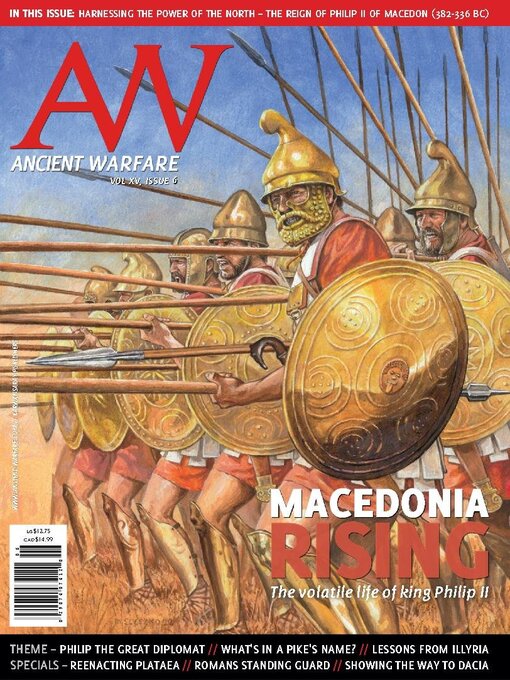Ancient Warfare is a unique publication focused exclusively on soldiers, battles, and tactics, all before 600 AD. Starting with ancient Egypt and Persia and continuing to the fall of the Western Roman Empire, Ancient Warfare examines the military history of cultures throughout Europe, the Middle East and parts of Asia and Africa. Ancient Greece and Rome receive the most frequent coverage, due both to the wealth of contemporary sources and the modern fascination with these two great civilizations. Subject-matter ranges from the familiar to the more obscure: while Alexander the Great, the Persian Wars and Caesar’s Gallic campaigns all receive regular coverage, Ancient Warfare also looks at some of the less common parts of ancient military history, from chariots as battle taxis to PTSD in antiquity.
Ancient Warfare Magazine
PRELIMINARIES NEWS ITEMS BY LINDSAY POWELL
Treasures great and small emerge at Vindolanda
Evidence for the Roman siege of Jerusalem
HAVE YOU READ?
Weapons recovered from Germanic gravesite
Letter to the editor
Spreading the cult of Asclepius
A REPORT FROM THE BATTLEFIELD OF PLATAEA, 2022 ON THE GROUND, IN KIT • It's very early morning. Rosy-fingered dawn is just touching the horizon, and we're marching by files up a steep hill to the main Spartan position, where 2500 years ago, 5000 hoplites and 35,000 helots, according to Herodotus, stood for days guarding the right flank of the Greek coalition army. We're fewer than 100 hoplites and we've only been on the battlefield three days, and already we have bruises and lacerations from walking in our greaves, drilling in the 40-degree sun, and crashing through the thorny, rocky landscape of Boeotia. The dance floor of Ares is not a comfortable place to make war, even pretend war.
Experimentation
MEMORIAL TO A ROMAN GENERAL THE PORTONACCIO SARCOPHAGUS • This monumental marble sarcophagus, now in the Museo Nazionale Romano, Palazzo Massimo alle Terme (Inv. 112.327) in Rome, was found in the Via della Cava di Pietralata, near the Via Tiburtina in the Portonaccio suburb (after which it is named), north of Rome near the ancient city of Veii.
THE RISE OF PHILIP OF MACEDON SOLDIER OR STATESMAN? • Philip II of Macedon (382-336 BC) is known for creating a military might capable of bringing the cities of Greece under his control. It was not, however, just his military might and innovation that enabled him to prevail in Greece. Philip's statecraft played a significant role in his success. His diplomatic skill was, arguably, even more extraordinary, and yet it is often overlooked.
A LESSON THAT GREECE FAILED TO LEARN JASON OF PHERAE • While focus on the ‘Rise of Macedon’ falls on the achievements of Philip II, an outline for the harnessing of the resources and manpower of the large, ‘uncivilized’ areas of northern Greece had been laid out a generation earlier in Thessaly.
THE XYSTON, LANCEA, KONTOS… AND MORE CALLING ALL MACEDONIAN PIKES • Typically accompanying Alexander the Great in the thick of battle were the Macedonian Companion cavalry (the Hetairoi), particularly the double-strength royal ile, later known as the agema. These units were armed with the xyston – or was that the lancea, or dory, or kontos …?
THE ILLYRIAN ROOTS OF THE MACEDONIAN ARMY PHILIP II AND BARDYLIS THE ILLYRIAN • In the summer of 359 BC, Perdiccas III, king of the Macedonians and older brother of Philip II, was killed in battle by a confederation of hill people, collectively called Illyrians by the Greeks. The fierce clans of Illyria and their wickedly effective cavalry and light infantry had raided the Macedonian kingdom seemingly since its inception, often with disastrous and lasting effects, as Perdiccas learned to his cost. And yet, without the Illyrians and their constant incursions into Macedon, the army that...

 AW XVII.5
AW XVII.5
 AW XVII.4
AW XVII.4
 AW XVII.3
AW XVII.3
 AW XVII.2
AW XVII.2
 AW XVII.1
AW XVII.1
 AW XVI.6
AW XVI.6
 AW XVI.5
AW XVI.5
 AW XVI.4
AW XVI.4
 AW XVI.3
AW XVI.3
 AW XVI.2
AW XVI.2
 AW XVI.1
AW XVI.1
 AW XV.6
AW XV.6
 AW XV.5
AW XV.5
 AW XV.4
AW XV.4
 AW XV.3
AW XV.3
